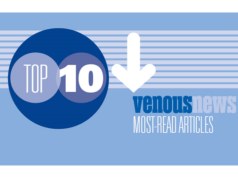
By David Dudzinski
Transthoracic echocardiography offers real-time information that assists vascular specialists in the diagnostic and prognostic evaluation of acute pulmonary embolism. Specific roles of transthoracic echocardiography are subject to local practice and expertise as there is no formulaic approach to applying echocardiography in acute pulmonary embolism. Basic fluency with transthoracic echocardiography findings and limitations allows the vascular specialist to integrate transthoracic echocardiography in the comprehensive evaluation of acute pulmonary embolism and decide when findings from transthoracic echocardiography could change management.
According to multisociety Appropriate Use Criteria, transthoracic echocardiography is not considered “appropriate” as a routine technique for establishing the diagnosis of acute pulmonary embolism, as other modalities like computed tomography (CT) exhibit higher sensitivity (>95% for CT versus ~30–70% for transthoracic echocardiography). While transthoracic echocardiography grants multiple views of the right ventricle, right atrium, inferior vena cava, and main pulmonary artery, transthoracic echocardiography has limited ability to image distal pulmonary artery branches. Nevertheless, transthoracic echocardiography has a role in assessing undifferentiated chest pain, dyspnoea, or haemodynamic insult, as it may elucidate contributing etiologies (pericardial effusion, left ventricle dysfunction, valvulopathy); alternatively, stigmata of right ventricle dysfunction or thrombus-in-transit could make acute pulmonary embolism the top working diagnosis. When a possible thrombus is visualised, the nature of the mass should be considered: venous thromboemboli are typically smooth with homogenous echotexture, mimicking a “cast” of deep veins. In contrast, densely laminated or irregularly echotextured masses shift considerations to non-venous thromboemboli, including tumours and endocarditis.
Transthoracic echocardiography functions as a rapid, bedside risk-stratification method useful in triaging to therapies such as thrombolysis or embolectomy. Examination, biomarkers, and electrocardiography contribute to severity assessment, however, while these parameters are binary (eg. “right ventricle heave” present or absent), transthoracic echocardiography generates information along a continuum (eg. right ventricle dimensions, pressures). Transthoracic echocardiography evidence of “right heart strain” includes right ventricle systolic dysfunction, right ventricle dilatation, and right sided overload, but no single measure is predictive of severity. In part this is a result of difficulty imaging the right ventricle due to its retrosternal location and its complex geometric shape (unlike the left ventricle). Instead, right ventricle base diameter provides clues to right ventricle dilatation, as two-dimensional and three-dimensional measures are less standardised; relative right ventricle: left ventricle dilatation is another important sign. Though ejection fraction is the gold standard for left ventricle assessment, only surrogate echocardiographic measures exist for the right ventricle. Because the right ventricle contracts primarily along its longitudinal axis, tricuspid annular systolic plane excursion (TAPSE) and systolic excursion velocity (S’) describe right ventricle function in terms of distance and speed, respectively, of right ventricle basal myocardial translation during contraction. TAPSE and S’ correlate with MRI measures of right ventricle global function, however, in right ventricle infarction and acute pulmonary embolism, they strictly reflect function of the right ventricle base only. Right ventricle wall motion abnormalities may be seen, with the combination of right ventricle free wall hypokinesis and relative apical hyperkinesis indicating acute cor pulmonale. Ventricular septal geometry may evince right ventricle pressure and/or volume overload. Dilatation of the right atrium, inferior vena cava, and pulmonary artery, tricuspid regurgitation, and elevated right ventricle systolic pressure all suggest right heart overload. Limitations to determination of right heart strain include inability to distinguish acuity versus chronicity: patients rarely have pre-acute pulmonary embolism transthoracic echocardiograms but may have pre-existing left heart or obstructive pulmonary disease that underlies insidious right ventricle dysfunction. Right ventricle hypertrophy will generally corroborate chronicity, but without knowledge of a patient’s “baseline” transthoracic echocardiogram, interpretation relies on reference to absolute, population-based standards. Proper interpretation therefore requires comprehensive integration of transthoracic echocardiography findings to render a holistic judgment of acute pulmonary embolism-related right ventricle dilatation and dysfunction.
Whether every acute pulmonary embolism patient needs urgent transthoracic echocardiography depends on overall risk parameters and which therapeutic options are being considered. For “massive” acute pulmonary embolism (patients with hypotension), advanced therapies are likely to be indicated regardless of echocardiography findings. Practically, transthoracic echocardiography is often conducted to exclude contributing diagnoses (shunt, left ventricle dysfunction) and to plan interventions. Transthoracic echocardiography’s main contribution to risk-stratification lies in assessment of symptomatic but non-hypotensive acute pulmonary embolism: those with biomarker evidence of myocardial necrosis or transthoracic echocardiography evidence of right ventricle dysfunction (“submassive” acute pulmonary embolism) face approximately 2–5 fold increased risks of short-term mortality and may benefit from advanced therapies. In PEITHO, thrombolysis reduced seven-day death or haemodynamic deterioration for patients with both elevated troponin and right ventricle dysfunction. Retrospective data suggested TAPSE >15 mm conferred robust negative predictive value for 30-day death or haemodynamic deterioration, and may reassure the vascular specialist about anticoagulation-only therapy.
In summary, early transthoracic echocardiography for every symptomatic acute pulmonary embolism patient informs risk-stratification, particularly for initially normotensive patients, and can justify choosing either advanced therapeutics or conservative therapy. Against routine transthoracic echocardiography is variability in the echocardiographic phenotype of acute pulmonary embolism and expertise required to properly interpret findings. Optimal timing of transthoracic echocardiography in acute pulmonary embolism remains unclear: Transthoracic echocardiography is generally non-emergent, though often obtained within 24 hours. Additionally, CT may depict right ventricle dilatation, offering the possibility of prognostic information concurrent with diagnosis. Our institutional practice is to obtain echocardiography within hours of identification of symptomatic acute pulmonary embolism patients who have exam, biomarker, or electrocardiographic indicia of right ventricle dysfunction or those with suspected right ventricle dysfunction (eg. large clot burden). We endeavour to integrate transthoracic echocardiography findings in multidisciplinary discussion of the management of acute pulmonary embolism.
David M Dudzinski, Massachusetts General Hospital and Harvard Medical School, Boston, USA









